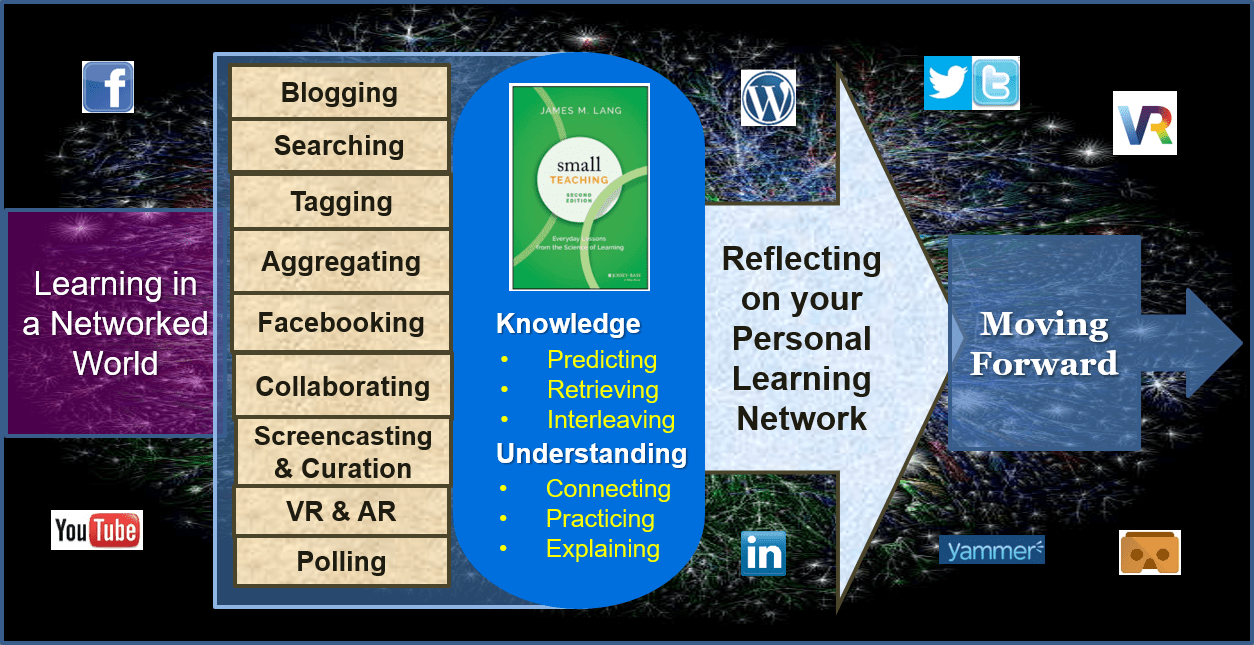This week, I once again started the Northeastern University class EDU-6323: Technology as a Medium for Learning.
I have taught this course twice a year since 2015 … and like the technology we cover, it continues to evolve. I have swapped out Michelle Miller’s (2014) book Minds Online to the newer Jim Lang Second Edition (2021) Small Teaching, which I discussed in my last post.
This will be my final 12-week course before I retire for good. The students come from a mix of backgrounds – K12, higher education, corporate, instructional design, and health care training. It is clear from their initial tweets and comments this week that the pandemic continues to impact their fields. This course is one for exploration … for defining both technologies that could enhance learning and processes that make these technologies viable.
Tony Bates in his post A Review of Online Learning 2021 noted that we should view COVID as endemic rather than pandemic – with us for the foreseeable future. He had suggested in his 2020 review that:
- Online and blended learning will increase substantially post Covid-19 (or perhaps ‘into the future’ is now more accurate.)
- Support for instructors is essential for quality online learning
- We know how to do quality online and blended learning, but we can also learn from emergency online learning
- COVID-19 showed the need for more flexible assessment methods
- COVID-19 resulted in innovative teaching, but will it stick?
- We are beginning to see the advantages of media and open educational resources for teaching and learning
- More attention needs to be paid to online access and equity
- We need more flexible learning spaces
- Administrators need to plan for flexibility and resilience in delivering teaching
- We need more (and better) data.
To this list, he added the growing use of blended learning, the need for more focused faculty development, the lack of equity in access (an issue that came up repeatedly in my class this week), and the need for even better and robust technologies.
Tony wondered what he had missed. My experience these past two years dovetails nicely with his … but I too wonder what I (we) have missed. An eLearning Industry post last week might have some clues.
In 6 EdTech Trends That Go All Out in 2022, Sean Bui noted that 2022 would be overtaken by tech buzzwords. I have to admit that I have been dealing with buzzwords since moving in to online education full time back in 2001! So nothing new there! Sean’s coming buzzwords:
- Animation
- AI
- VR/AR
- Blockchain Technology
- Big Data
- Cloud Computing
For each of these, Sean gives benefits, noting that human resources and budgets may be more of a barrier than technology. As I look through this list, there are connections to my course and misses. Animation comes up in discussing screencasting and curation. AI is not a separate subject, but aspects of AI appear almost every week. We do spend a week on virtual and augmented reality.
What I do not spend much time on is blockchain (still pretty low on the Hype Cycle for me), Big Data (which I suspect will come up as we explore analytics), and Cloud Computing (which in some ways I see as mainstream these days).
I guess I am glad Nonfungible Tokens (NFT) did not come up as well!
Tony believed that we in elearning have made considerable progress this past year, noting “…We learned a lot about online learning during Covid-19, and while not all these lessons were good, the landscape of teaching and learning has altered, in general for the best.”
I have been teaching online for most of the past 25 years. I have seen lots of change. As I and my students explore technology as a medium for learning, I continue to wonder what the next 25 years will bring! Years of experience also means years of baggage … the “how I have always done it” syndrome. For my students and other readers, if you were designing this course now, how would you craft it? After all, as Derek Bruff noted in his 2019 book Intentional Tech, blackboard, whiteboards, and even the wheels on the bottom of moveable chairs are all classroom technologies. Where would you take this course?
I would be interested in your thoughts!

Hi Britt, thank you for such an informative post. I do not feel confident in my ability to answer your closing question now, but I will revisit it in a couple months! I am also honored and fortunate to be a part of this class now knowing it will be your last before retirement!
~Marc